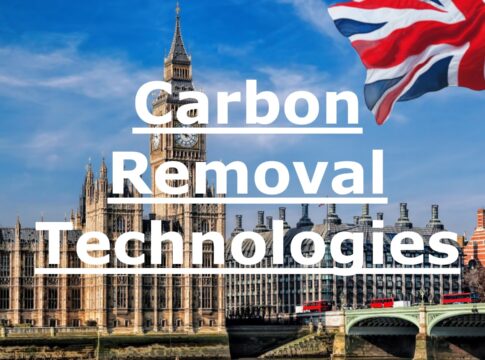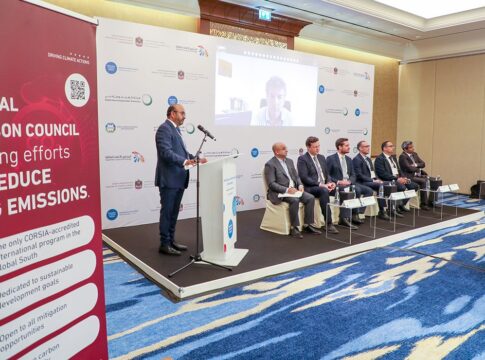UK Invests £54M in 15 Projects Developing Carbon Removal Technologies
The UK government invested £54 million into 15 projects that develop carbon removal technologies.
The funding comes under Phase 2 of the Direct Air Capture and Greenhouse Gas Removal technologies competition. It’s worth a total of £60 million with 23 winners during its Phase 1. Out of those, 15 were able to progress to Phase 2 that will receive a total of £54.4 million.
The investment will help projects to further develop their GHG removal technologies. These include a machine that pulls CO2 out of the air, a system that removes CO2 from seawater, and a plant that converts waste into hydrogen.
As per Energy and Climate Change Minister Greg Hands:
“This £54 million government investment announced today will help establish a greenhouse gas removal industry in the UK… which could be worth billions to our economy, bringing in private investment and supporting the creation of new green jobs.”
Establishing Carbon Removal Technologies in the UK
This UK government program is funded through the BEIS Net Zero Innovation Portfolio. It provides support for the following 4 major types of carbon removal technologies.
Direct Air Carbon Capture (DACC): this technology uses chemical reactions to capture CO2 from the air as it passes through the system. The captured CO2 can then be stored or used in making products or applications.
Bioenergy Carbon Capture and Storage (BECCS): captures and stores carbon from organic materials. Then the technology converts it into useful energy such as heat, electricity, liquid or gas fuels.
Biochar: a form of charcoal produced when organic matter burns without oxygen. Biochar is rich in carbon and can be a fertilizer.
Seawater: The oceans absorb CO2 but because of a big increase in carbon emissions from human activities, they suck in more than before. So they’re becoming more acidic. This technology can remove CO2 from seawater directly to help restore its natural balance.
These carbon removal technologies are vital to meeting net zero carbon emissions by 2050. So funding the projects that develop them is very important.
While the UK government is working hard to transition away from fossil fuels, carbon removal technologies are also crucial to offset emissions from hard-to-abate sectors.
This recent investment will contribute towards building a thriving carbon removal industry in the UK. In fact, the government has sought advice from stakeholders on how it can help put the UK at the forefront of the carbon removal sector.
Here’s the sneak peek of the 15 projects that won the competition.
1. Advanced Biofuel Solutions Ltd. – “Biohydrogen Greenhouse Gas Removal Demonstration”. Project funding: £4,750,429.16.
This project will take a synthesis gas from household waste and convert it into low carbon hydrogen for use in road transport. All the while capturing CO2 from the process for use in the industry.
2. Black Bull Biochar Ltd. – “The Biochar Platform”. Project funding: £2,997,622.15.
This project aims to pilot a business-to-business (B2B) platform that creates the first fully integrated biochar system in the world. It can help develop the carbon removal technologies industry in the UK by removing ~50,000 tons by 2030.
3. Cambridge Carbon Capture Ltd. – “Direct Air CO2 Capture and Mineralization (DACMIN)”. Project funding: £2,999,964.00.
This DAC project will deliver a pilot plant that captures 100 tons of CO2/year from the air using the firm’s CO2LOC technology. It seeks to build, test, and assess the CO2LOC technology to provide data to aid a computer model of a plant designed to capture 50kt CO2/year.
4. CO2CirculAir B.V. – “SMART-DAC”. Project funding: £2,941,301.44.
This innovative DAC tech uses wind to capture CO2 via membrane gas absorption (through electrodialysis). It assures a 24 hours/day CO2 absorption using stable liquid absorbent with no use of heat but only electricity from renewable sources.
5. Coal Products Limited (CPL) – “Bio-waste to biochar (B to B) via Hydrothermal Carbonization and Post-Carbonization”.
Project funding: £4,997,822.00.
This biochar project will provide the possibility of turning biowaste into biochar in an optimized process design and large-scale production. Biowaste has high potential to improve the supply of raw materials for biochar production. Biochar can make a big contribution to the UK goal of removing 35M tons of carbon/year by 2050.
6. Ince Bio Power Limited – “Ince Bioenergy Carbon Capture & Storage (INBECCS) – Phase 2”. Project funding: £4,992,408.30.
The INBECCS Project will design and deliver a 10 ton/day carbon capture pilot plant at the HyNet North West industrial cluster. It seeks to pioneer the first commercial scale carbon capture on a biomass waste gasification facility.
7. KEW Projects Ltd. – “CCH₂: Carbon Capture and Hydrogen”. Project funding: £4,998,409.19.
This project will show how a modular BECCS hydrogen system can deliver 50ktCO2/year of carbon removal during 2025-2030. It will also demonstrate how it can scale to 24 MtCO2/year in the following decade.
8. Lapwing Energy Limited – “Reverse Coal”. Project funding: £2,999,822.60.
Reverse Coal is an engineered natural solution to remove CO2 from the air and bury it underground in the form of a carbon rich char, akin to coal. It will not only provide carbon sequestration but also avoid further emissions from peatlands by rewetting. The project can scale to remove over 1Mt of CO2/year.
9. Mission Zero Technologies Ltd – “Project DRIVE (Direct Removal through Innovative Valorization of Emissions)”. Project funding: £2,997,822.16.
The project will build, deliver, and operate a 120 tCO2/year DAC pilot plant based on Mission Zero’s IP. This DAC tech can reduce energy use and cost by 3x – 5x compared to today’s levels. It can also bring CO2 into useful applications while locking it away for good like manufactured limestone.
10. NNB Generation Company (SZC) Limited – “DAC powered by Nuclear Power Plant”. Project funding: £3,000,000.00.
This project will develop and build a heat-powered DAC plant that offers higher efficiency and less reliance on electricity than current DAC tech. If scaled up, this DAC plant can capture 1.5 million tons of CO2/year using 400MWh of heat from the power plant. This carbon removal capacity can offset the UK’s entire railway transport emissions.
11. Ricardo UK Ltd. – “BIOCCUS”. Project funding: £2,986,349.43.
This unique project combines biochar production and CCUS (carbon capture, use and storage). It seeks to test a new biomass pyrolysis based cogeneration system with BIOCCUS to help scale carbon removal technologies in the UK. It uses forestry waste to create biochar, CO2, electricity and heat.
12. Rolls-Royce plc – “ENCORE (ENvironmental CO2 REmover) Phase 2”. Project funding: £2,812,704.12.
This innovative system will enable the widespread, low-cost CO2 removal by using a low regeneration temperature and very durable absorption liquid tech. It’s designed with engineering expertise to provide a very efficient and flexible product.
13. SAC Commercial – “GreenShed”. Project funding: £2,934,428.75.
This initiative aims to reduce emissions in the livestock farming sector by developing an integrated low carbon, circular, cattle and vertical farming system. It will capture methane (with 26x more warming impact than CO2 over a century) from housed cattle. The system will then use the heat, CO2, and power from methane combustion to produce low carbon produce. If implemented across the sector this can lead to 50% emissions reduction from these systems.
14. Severn Wye Energy Agency – “Mersey Biochar”. Project funding: £2,934,428.75.
The project’s goal is for small scale biochar processing facilities to connect onto communal and district heat networks. This will decarbonize heat and energy through biochar pyrolysis technology that turns underused biomass into biochar. And so, it captures carbon during the process and sequesters it for a very long time.
15. University of Exeter – “SeaCURE”. Project funding: £2,999,848.34.
SeaCURE uses the natural behavior of the carbon cycle – the ‘sucking’ of CO2 from the air by rising atmospheric CO2 levels in the ocean. The system leverages this natural CO2 capture by stripping >90% of the CO2 out of the seawater so that the CO2 gradient between air and seawater grows. In effect, there’s more CO2 removed from the atmosphere because there’s higher concentration of this gas in seawater than in air.
The post UK Invests £54M in 15 Projects Developing Carbon Removal Technologies appeared first on Carbon Credits.



